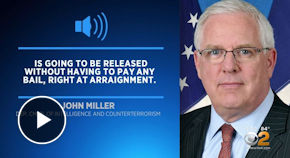|
Special Series: New
York's New Bail Law Coming Jan. 1, 2020
Another New Law Impacting Retail LP & ORC Big Time
New York's New No-Bail Law & Grand Larceny - In Effect Jan. 1st, 2020
Mandatory Appearance Tickets - Mandatory Release - Mandate Ability to Pay
Yet the relative lack of fanfare over the passage of New York’s new bail law
belies its historic and transformative potential to end mass incarceration at
the local level. If implemented effectively, a conservative estimate of the
legislation’s impact suggests that New York can expect at least a 40 percent
reduction overall in the state’s pretrial jail population.
That bests the 30.4 percent reduction achieved by bail reform in New Jersey, and
the anticipated impact of Senate Bill 10 in California— which is currently on
hold pending a challenge by the bail bond industry—if it goes into effect in
2020.
.jpg) The
governor and the legislature entered the 2019 legislative session under
heightened scrutiny from advocates and progressive reformers to truly reform
New York’s criminal justice system. The
governor and the legislature entered the 2019 legislative session under
heightened scrutiny from advocates and progressive reformers to truly reform
New York’s criminal justice system.
In August 2018, California passed and Governor Jerry Brown signed into law
Senate Bill 10, making it the first state in the country to fully eliminate
money bail. Suddenly, it was no longer radical to propose taking money out of
the pretrial equation entirely. Second, the same organizing and advocacy that
flipped the New York Senate from red to blue had changed the narrative on
criminal justice reform.
49 states, all except New York, have changed their bail laws to allow
judges to consider both risk of failure to appear and public safety in
pretrial decisions.
The final bill that passed eliminated money bail and mandated release for 90
percent of all arrests statewide.
On misdemeanors, judges must either release the person on their own
recognizance or set nonmonetary conditions, including court-ordered pretrial
supervision.
On all nonviolent felonies, if release on recognizance isn’t granted, judges may
impose nonmonetary pretrial conditions, including electronic monitoring.
Under the new law, when judges set bail they must consider a person’s ability to
pay bail and the hardship it will impose.
Five distinctions that set New York’s new bail law apart from other efforts at
bail reform
If you can make it in New York, you can make it anywhere - across the
country, other cities and states should and will be looking to New York as a
model for pretrial justice. After all, if bail reform succeeds in New York—a
vast state with varied geographies—it can succeed anywhere.
Click here to read highlights of the law
NYPD Counterterror Chief John Miller Slams New York’s Bail Reform Plan
 The
NYPD‘s Deputy Commissioner of Intelligence and Counter-terrorism says New York
is bound for trouble if the new bail reform plan goes into effect next year. In
2020, new criminal justice reform will eliminate cash bail in New York. It calls
for people arrested on low-level misdemeanors or nonviolent felonies to be
released without bail, until trial. The
NYPD‘s Deputy Commissioner of Intelligence and Counter-terrorism says New York
is bound for trouble if the new bail reform plan goes into effect next year. In
2020, new criminal justice reform will eliminate cash bail in New York. It calls
for people arrested on low-level misdemeanors or nonviolent felonies to be
released without bail, until trial.
“Before they enacted this law, 89%, 89% of people were being released at
arraignment without having to pay bail anyway,” Miller said. “Now that’s going
to go to probably 99%, which is going to be a problem because criminals are
going to know at the time they’re arrested ‘I’m not really risking going to
jail, I’m not really risking anything except going through the system and coming
out at the other end.'”
“You’re talking about people who can sell pounds of cocaine and walk out with
no bail. Someone burglarizes your house and walks out with no bail,” Monahan
said. “We’re going to be facing some major issues come Jan. 1 if this doesn’t
get changed.”
According to a study by the Data Collaborative for
Justice, had the 2020 bail reforms been in place last year, about 20,000 more
defendants would have been released without bail compared to the number actually
released.
The NYPD and the police union both say the no bail law will make it much more
difficult to deter crime.
New Jersey eliminated cash bail in 2017. There, 26.9% of defendants released
without bail before trial were charged with a new crime, just slightly more than
the 24.2% in 2014.
cbslocal.com
Will Prosecutors Attempt to Neuter New York's Bail Reforms?
Reformers worry that district attorneys will subvert new rules, but
prosecutors worry about those who refuse to show up for court.
 The
reforms were pushed through
in April as part of the state's 2020 budgeting process. As prosecutors and
courts prepare for the new rules, Jed Painter, assistant district attorney for
Nassau County (on Long Island), has been giving presentations on how these new
bail rules work. The
reforms were pushed through
in April as part of the state's 2020 budgeting process. As prosecutors and
courts prepare for the new rules, Jed Painter, assistant district attorney for
Nassau County (on Long Island), has been giving presentations on how these new
bail rules work.
Painter has problems with these new bail rules and says so.
Critics say he's encouraging prosecutors in New York to look for ways to
manipulate the new system in order to keep defendants behind bars with high cash
bail demands.
The push to reduce or completely eliminate cash bail is one of several recent
trends by criminal justice reformers attempting to cut back on the number of
people
unnecessarily locked behind bars. While bail had originally been intended as
a way to make sure defendants show up for court dates, it has long become a
thoughtless, bureaucratic machine that often simply orders defendants to pay
money or stay stuck behind bars, sometimes for weeks or months, even though they
have not been convicted. The end result has been that people's pretrial
detention status depended not on whether the defendant was deemed dangerous or a
flight risk, but whether he or she had access to money or could pay a bail
bondsman.
City & State New York listened to a
podcast post of one of Painter's presentations where he gave some
"suggestions" on dealing with some defendants that had the whiff of trying to
subvert the new guidelines to keep them behind bars.
reason.com
DAs trained how to keep people in jail despite new bail law
Jed Painter, an assistant district attorney from Nassau County, has been giving
presentations on New York’s new state laws that limit bail, expand discovery in
criminal cases and encourage speedy trials to audiences of lawyers and
legislators across the state. But critics say Painter’s presentation helps
prosecutors find legal loopholes to hold more defendants on bail and to delay
trials.
Painter, who serves as general counsel to Nassau County District Attorney
Madeline Singas, a Democrat, has been delivering a presentation on the new laws
as part of the New York Prosecutors Training Institute, or NYPTI, the training
arm of the District Attorneys Association of the State of New York. DAASNY was a
major voice in the debate over the reforms that passed in this year’s state
budget, and suggested less ambitious reforms than plans proposed by Gov. Andrew
Cuomo and Democratic lawmakers.
In the course of the nearly 90-minute July 13 presentation provided by NYPTI as
a podcast, Painter gave tips to the audience of prosecutors on how to jail
people that otherwise would be released under the new law. Under the law
going into effect on Jan. 1, 2020, defendants can be held pretrial if they miss
a court appearance and don’t appear for 30 days. So Painter gives what he called
a “practice pointer you can tell your police”: If a defendant warranted on a
felony doesn’t show up to court, “don’t pick them up right away. Don’t be their
Uber,” he said. “You’re not going to get bail on them for that violation. Wait
the 30 days, and then you’ve got your bail jumping charge waiting for them.”
Painter added that “if public safety is an issue, you don’t want to wait the
30 days,” but he seemed to be encouraging prosecutors to find a way to hold
defendants pretrial.
cityandstateny.com
|